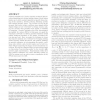Free Online Productivity Tools
i2Speak
i2Symbol
i2OCR
iTex2Img
iWeb2Print
iWeb2Shot
i2Type
iPdf2Split
iPdf2Merge
i2Bopomofo
i2Arabic
i2Style
i2Image
i2PDF
iLatex2Rtf
Sci2ools
FPGA
2010
ACM
2010
ACM
FPGA power reduction by guarded evaluation
Guarded evaluation is a power reduction technique that involves identifying sub-circuits (within a larger circuit) whose inputs can be held constant (guarded) at specific times during circuit operation, thereby reducing switching activity and lowering dynamic power. The concept is rooted in the property that under certain conditions, some signals within digital designs are not “observable” at design outputs, making the circuitry that generates such signals a candidate for guarding. Guarded evaluation has been demonstrated successfully for custom ASICs; in this paper, we apply the technique to FPGAs. In ASICs, guarded evaluation entails adding additional hardware to the design, increasing silicon area and cost. Here, we apply the technique in a way that imposes minimal area overhead by leveraging existing unused circuitry within the FPGA. The primary challenge in guarded evaluation is in determining the specific conditions under which a sub-circuit’s inputs can be held constant...
| Added | 17 Mar 2010 |
| Updated | 17 Mar 2010 |
| Type | Conference |
| Year | 2010 |
| Where | FPGA |
| Authors | Chirag Ravishankar, Jason Helge Anderson |
Comments (0)

